Zhytomyr
Zhytomyr (Ukrainian: Жито́мир, romanized: Žytómyr [ʒɪˈtɔmɪr]; Russian: Жито́мир, romanized: Žitómir [ʐɨˈtomʲɪr]; Polish: Żytomierz; Yiddish: זשיטאָמיר, romanized: Žitomir) is a city in the north of the western half of Ukraine. It is the administrative center of Zhytomyr Oblast (province), as well as the administrative center of the surrounding Zhytomyr Raion (district). The city of Zhytomyr is not a part of Zhytomyr Raion: the city itself is designated as its own separate raion within the oblast; moreover Zhytomyr consists of two so-called "raions in a city": Bohunskyi Raion and Koroliovskyi Raion (named in honour of Sergey Korolyov). Zhytomyr occupies an area of 65 square kilometres (25 square miles). Its population is 266,936.
Zhytomyr Житомир Żytomierz • זשיטאָמיר | |
|---|---|
 | |
 Flag 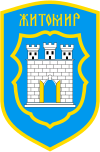 Coat of arms | |
 Zhytomyr  Zhytomyr | |
| Coordinates: 50°15′0″N 28°40′0″E | |
| Country | |
| Oblast | |
| Raion | Zhytomyr City |
| Founded | 884 |
| Government | |
| • Mayor | Serhii Sukhomlyn |
| Area | |
| • Total | 61 km2 (24 sq mi) |
| Elevation | 221 m (725 ft) |
| Population (2018) | |
| • Total | 266,936[1] |
| Time zones | UTC+2 (winter) |
| UTC+3 (summer DST) | |
| Postal code | 10000 — 10036 |
| Area code(s) | +380 412 |
| Website | Zhytomyr |
Zhytomyr is a major transportation hub. The city lies on a historic route linking the city of Kiev with the west through Brest. Today it links Warsaw with Kiev, Minsk with Izmail, and several major cities of Ukraine. Zhytomyr was also the location of Ozerne airbase, a key Cold War strategic aircraft base 11 kilometres (6.8 miles) southeast of the city.
Important economic activities of Zhytomyr include lumber milling, food processing, granite quarrying, metalworking, and the manufacture of musical instruments.[2]
Zhytomyr Oblast is the main center of the Polish minority in Ukraine, and in the city itself there is a Latin Catholic cathedral and large Roman Catholic Polish cemetery, founded in 1800. It is regarded as the third biggest Polish cemetery outside Poland, after the Lychakivskiy Cemetery in Lviv and Rasos Cemetery in Vilnius.
History
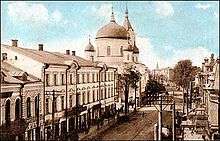
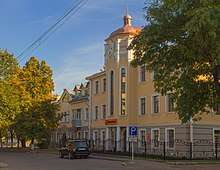
_.jpg)
Legend holds that Zhytomyr was established about 884 by Zhytomyr, prince of a Slavic tribe of Drevlians. This date, 884, is cut in the large stone of the ice age times, standing on the hill where Zhytomyr was founded. Zhytomyr was one of the prominent cities of Kievan Rus'. The first records of the town date from 1240, when it was sacked by the Mongol hordes of Batu Khan.
In 1320 Zhytomyr was captured by the Grand Duchy of Lithuania and received Magdeburg rights in 1444. After the Union of Lublin (1569) the city was incorporated into the Crown of the Polish Kingdom and in 1667, following the Treaty of Andrusovo, it became the capital of the Kiev Voivodeship. In the Second Partition of Poland in 1793 it passed to Imperial Russia and became the capital of the Volhynian Governorate.
Following the Union of Lublin, Zhytomyr (known in Polish as Żytomierz) became an important center of local administration, seat of the starosta, and capital of Żytomierz County. Here, sejmiks of Kiev Voivodeship took place. In 1572, the town had 142 buildings, a manor house of the starosta and a castle. Following the privilege of King Sigismund III Vasa, Zhytomyr had the right for two fairs a year. The town, which enjoyed royal protection of Polish kings, prospered until the Khmelnytsky Uprising (1648), when it was captured by Zaporozhian Cossacks and their allies, Crimean Tatars. Its residents were murdered, Zhytomyr was burned to the ground, and all government files were destroyed. In 1667, Zhytomyr became capital of Kiev Voivodeship, and in 1724, a Jesuit school and monastery were opened here. By 1765, Zhytomyr had five churches, including 3 Roman Catholic and 2 Orthodox, and 285 houses.
In 1793 Zhytomyr was annexed by the Russian Empire, and in 1804 was named capital of the Volhynian Governorate. In 1798, a Roman Catholic Diocese of Zhytomyr was established. During the January Uprising, the town was a stronghold of Polish rebels.
During a brief period of Ukrainian independence in 1918 the city was for a few weeks the national capital. Nicolas Werth claims that armed units of the Ukrainian People's Republic were also responsible for rapes, looting, and massacres in Zhytomyr, in which 500–700 Jews lost their lives. From 1920 the city was under Soviet rule. Under Soviet rule a German National District was set up in the area for the German minority, according to Soviet minorities policy before World War II.
During World War II Zhytomyr and the surrounding territory was, for two and a half years (first from July 9, 1941 to November 12, 1943 and again from November 19, 1943 to December 31, 1943) under Nazi German occupation and was Heinrich Himmler's Ukrainian headquarters. The Nazi regime in what they called the "Zhytomyr General District" became what historian Wendy Lower describes as
a laboratory for… Himmler's resettlement activists… the elimination of the Jews and German colonization of the East—transformed the landscape and devastated the population to an extent that was not experienced in other parts of Nazi-occupied Europe besides Poland. [While]… [u]ltimately, the exigencies of the war effort and mounting partisan warfare behind the lines prevented Nazi leaders from fully developing and realizing their colonial aims in Ukraine… In addition to the immediate destruction of all Jewish communities, Himmler insisted that the Ukrainian civilian population be brought to a 'minimum.'[3]
From 1991, the city has been part of the independent Ukraine.
Population
Demographic history
| Year | Inhabitants |
|---|---|
| 1861 | 40,564 |
| 1891 | 69,785 |
| 1897 | 65,895 (of whom (by language) 31,000 Jews, 17,000 Russians, 9,000 Ukrainians, 7,000 Poles)[4] |
| 1926 | 76,700 (of whom 10,500 were Russians)[5] |
| 1939 | 95,100[6] |
| 1941 | 40,100 (Russians along with Poles, Jews, and Germans in minority)[6] |
| 2005 | 277,900 |
| 2015 | 269,493[7] |
Roman Catholics
Zhytomyr had been a Latin Catholic bishopric since 1321, until the see was suppressed in 1789 in favor of the Diocese of Lutsk and Zytomierz, until that was split up again in 1925, when it was restored as the Roman Catholic Diocese of Zhytomyr; that was formally suppressed in 1998 to establish the Diocese of Kyïv–Žytomyr, but actually the city retains the episcopal see in its Cathedral of the Holy Wisdom, while Kiev (although first in the title and the national capital) only has a co-cathedral.[8]
The Zhytomyr cemetery was opened in 1800. At first, it served Polish nobility from Volhynia, such as the Czeczel and the Woronicz families. Later, other Catholics were buried here, including Germans, Ukrainians and Russians.
In 1840, the Chapel of St. Stanislaus was built (now in ruins), and the cemetery was divided into nine districts, named after different saints. In the Soviet Union, the complex was devastated, now it is under the process of renovation.
Among most famous people buried here are:
- Bronislaw Matyjewicz-Maciejewicz, one of the first Polish air pilots
- Karol Niedzialkowski - bishop of Lutsk and Zhytomir in the late 19th century
- Apolinary Wnukowski - Roman Catholic archbishop and scholar
- Juliusz Zarębski - Polish composer
- parents of Ignacy Jan Paderewski
- the family of Stanisław Moniuszko
Jews in Zhytomyr
Zhytomyr apparently had few Jews at the time of the Khmelnytsky Uprising (1648), but by the time it became part of Russia in 1778, it had a large Jewish community, and was a center of the Hasidic movement. Jews formed nearly one-third of the 1861 population (13,299 in 40,564); thirty years later, they had somewhat outpaced the general growth of the city, with 24,062 Jews in a total population of 69,785. By 1891 there were three large synagogues and 46 smaller batei midrash. The proportion of Jews was much lower in the surrounding district of Zhytomyr than in the city itself; at the turn of the century (circa 1900) there were 22,636 Jews in a total population of 281,378.
In Imperial Russia, Zhytomyr held the same status as the official Jewish center of southern part of the Pale of Settlement as Vilnius held in the north. The printing of Hebrew books was permitted only in these two cities during the monopoly of Hebrew printing from 1845 to 1862, and both were chosen as the seats of the two rabbinical schools which were established by the government in 1848 in pursuance of its plans to force secular education on the Jews of Russia in accordance with the program of the Teutonized Russian Haskalah movement. The rabbinical school of Zhytomyr was considered the more Jewish, or rather the less Russianized, of the two (Ha-Meliẓ, 1868, No. 40, cited in Jewish Encyclopedia). Its first head master was Jacob Eichenbaum, who was succeeded by Hayyim Selig Slonimski in 1862. The latter remained at the head of the school until it was closed (together with the one at Vilnius) in 1873 because of its failure to provide rabbis with a secular education who should be acceptable to the Jewish communities. Suchastover, Gottlober, Lerner, and Zweifel were among the best-known teachers of the rabbinical school at Zhytomyr, while Abraham Goldfaden, Salomon Mandelkern, and Abraham Jacob Paperna were among the students who later became famous in the Jewish world.
The Jewish community of Zhytomyr suffered pogroms:
- 1) On May 7–8, 1905, when the section of the city known as "Podol" was devastated, and 20 were killed within the city.
- 2) On January 7–10, 1919, 15 young Jewish neighbors were killed when they came to defend, and the Christian student Nicholas Blinov, also attempting to defend, likewise lost his life. Ten young Jews from nearby Chudnov were also killed while on their way to aid the Jews of Zhytomyr.[9]
- 3) Beginning on March 22, 1919, according to witnesses, the 317 deaths were fewer than might have been, due to both Christian sheltering efforts and the return of the Bolshevik troops within a few days.[10]
The Jewish community of the region was largely destroyed in the Holocaust. In the four months beginning with Himmler's 25 July 1942 orders, "all of Ukraine's shtetls and ghettos lay in ruins; around 3,000[11] Jewish men, women, and children were murdered by stationary and mobile SS-police units with local Ukrainian auxiliaries."[3]
Today, the Zhytomyr Jewish community numbers about 5,000. The community is a part of the "Union of Jewish Communities in Ukraine" and the city and district's rabbinate. Rabbi Shlomo Vilhelm, who came to the city as a Chabad emissary in 1994, serves as rabbi. Other Jewish institutions are also active in the city, including the Joint and its humanitarian branch "Chesed" and the Jewish Agency.
The community has an ancient synagogue in the city center which has a mikveh. Chabad operates in the city various educational institutions which have residence in a village next to the city.
Culture
The internationally renowned chamber choir OREYA is based in the city.
One of the world-famous museums of cosmonautics Sergei Pavlovich Korolyov Museum of Cosmonautics is located in the city.
Geography

Zhytomyr lies in a unique natural setting; all sides of the city are surrounded by ancient forests through which flow the Teteriv, Kamianka, Kroshenka and Putiatynka rivers. The Teteriv river generally forms the southern boundary of Zhytomyr, though there are also some small areas of Zhytomyr city territory below the southern bank of the river. The city is rich in parks and public squares.
Zhytomyr is set out on a mostly radial type of street net with the centre at the main public square of the city, named Sobornyi Maidan (which means Cathedral Square). A building containing courts and some other institutions is in the west of the square. Before 1991, this building contained Zhytomyr Oblast Committee of the Communist Party. Just behind the building (that is to the west of Sobornyi Square) is a small quiet park, bearing the name of Zamkova Gora (Castle Mountain) and containing a monument-type boulder with an inscription stating that this is a place where Zhytomyr was founded. This historical centre of Zhytomyr is in the south part of the city. The old part of Zhytomyr is on three rocky hills over the river Kamianka: Okhrimova, Zamkova, and Petrovska.
The old town is surrounded by new housing estates, the names of which are often borrowed from the former suburban villages or reflect the longstanding occupations common in these places. The main streets connecting Sobornyi Maidan with the outskirts of Zhytomyr are Kyivska Street or Kiev Street (going to northeast, to the railway station and also to the main bus station of the city), Velyka Berdychivska Street (going to southeast), Lech Kaczyński Street (going southwest; its further continuation is Chudnivska Street going to beaches and a forest-type park near the river of Teteriv), and Peremohy Street (going north).
The best-known street in the central part of Zhytomyr is Mykhailivska (named after St. Michael's Church at the northern end of the street). The street is about 500 metres to the east of Sobornyi Maidan and runs approximately from north to south, connecting some points at the above-mentioned Kyivska Street and Velyka Berdychivska. Mykhailivska Street is for pedestrian traffic: vehicles are forbidden, with the exception of some slow-moving ones. A puppet theatre is nestled in the middle of the street, while the building of the Zhytomyr City Council is at its southern end. Several small coffee houses and cafés have sprung up here recently, frequented by locals from all walks of life and of all ages. If one crosses Velyka Berdychivska Street from the southern end of Mykhailivska Street, then one finds oneself at Korolyov Square containing the building of the Zhytomyr Oblast Council. Crossing Kyivska Street from the northern end of Mykhailivska Street, one can continue to go along Pokrovska Street, another important long avenue of Zhytomyr (going north).
The best-known park of Zhytomyr is named after Yuri Gagarin, in the south of the city, at the left (northern) bank of the Teteriv River. It was formerly owned by the Baron de Chaudoir.
Climate
| Climate data for Zhytomyr | |||||||||||||
|---|---|---|---|---|---|---|---|---|---|---|---|---|---|
| Month | Jan | Feb | Mar | Apr | May | Jun | Jul | Aug | Sep | Oct | Nov | Dec | Year |
| Record high °C (°F) | 5.0 (41.0) |
5.0 (41.0) |
12.0 (53.6) |
22.0 (71.6) |
27.0 (80.6) |
29.0 (84.2) |
32.0 (89.6) |
31.0 (87.8) |
27.0 (80.6) |
21.0 (69.8) |
13.0 (55.4) |
7.0 (44.6) |
32.0 (89.6) |
| Average high °C (°F) | −2.8 (27.0) |
−1.4 (29.5) |
3.5 (38.3) |
11.9 (53.4) |
19.6 (67.3) |
22.9 (73.2) |
24.9 (76.8) |
24.0 (75.2) |
19.1 (66.4) |
11.9 (53.4) |
4.1 (39.4) |
−0.7 (30.7) |
11.4 (52.5) |
| Daily mean °C (°F) | −5.7 (21.7) |
−4.9 (23.2) |
−0.4 (31.3) |
7.0 (44.6) |
13.9 (57.0) |
17.0 (62.6) |
18.9 (66.0) |
17.8 (64.0) |
13.1 (55.6) |
7.2 (45.0) |
1.3 (34.3) |
−3.2 (26.2) |
6.8 (44.2) |
| Average low °C (°F) | −8.8 (16.2) |
−8.3 (17.1) |
−3.7 (25.3) |
2.6 (36.7) |
8.3 (46.9) |
11.6 (52.9) |
13.3 (55.9) |
12.4 (54.3) |
8.1 (46.6) |
3.2 (37.8) |
−1.4 (29.5) |
−5.6 (21.9) |
2.6 (36.7) |
| Record low °C (°F) | −35.0 (−31.0) |
−35.0 (−31.0) |
−27.0 (−16.6) |
−11.0 (12.2) |
−4.0 (24.8) |
1.0 (33.8) |
5.0 (41.0) |
2.0 (35.6) |
−5.0 (23.0) |
−20.0 (−4.0) |
−23.0 (−9.4) |
−31.0 (−23.8) |
−35.0 (−31.0) |
| Average precipitation mm (inches) | 32 (1.3) |
29 (1.1) |
31 (1.2) |
38 (1.5) |
53 (2.1) |
66 (2.6) |
78 (3.1) |
75 (3.0) |
50 (2.0) |
41 (1.6) |
43 (1.7) |
34 (1.3) |
570 (22.4) |
| Source: Sistema de Clasificación Bioclimática Mundial[12] | |||||||||||||
Economy
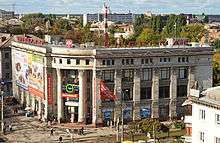
Zhytomyr is an important economic center in the region. Enterprises in the city include glass, metal fabrication, electronic devices, screens, fabrics, furniture, shoes and others. In addition, a large pharmaceutical factory is in Zhytomyr. Since 1944, a confectionery factory (ALC "ZhL") works in Zhytomyr; the enterprise is one of the leaders of Ukrainian confectionery market.[13]
The city is home to the Zhytomyr Armored Factory. The factory has been one of the main repair facilities in Ukraine since the start of the War in Donbass, running on 3 shifts. In September 2014 it was announced that the Ministry of Defence of Ukraine had placed a 280 million hryvnia order with the factory.[14][15]
Transport
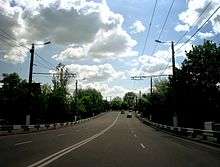
In ancient times, the city was on the important road from Kiev to the city of Brest-Litovsk.
Now this road is of international highway ![]()
![]()
Some other roads:



- P18 Zhytomyr - Stavyshche (through Skvyra)
- P28 Zhytomyr - checkpoint "Vystupovychi" of the Ukrainian-Belarusian border (through Korosten).
Railways connect Koziatyn with Zhytomyr (through Berdychiv), Korosten, Novohrad-Volynskyi, Korostyshiv and Fastiv. In 2011 a stretch of the Fastiv — Zhytomyr rail line was electrified.
Zhytomyr is about 131 kilometers from Kiev (by road 140 km, by rail 165 km).
The following trains pass through Zhytomyr train station (both directions for all):
- Zhytomyr - Korosten
- Vinnytsia - Korosten
- Zhytomyr - Korostyshiv
- Korosten - Koziatyn
- Zhytomyr - Koziatyn
- Zhytomyr - Novohrad-Volynskyi
- Zhytomyr - Fastiv
The city has an airport (however it is not currently being used for passenger transport; it is intended for the use of strategic bombers, though not currently being used).
Zhytomyr has three bus stations connecting it with many other cities and villages in Ukraine and abroad.
Zhytomyr has fifteen bridges and junctions built over rivers and roads. There is a 30-kilometer ring road around Zhytomyr.
The most interesting bridge in Zhytomyr is one over the Teteriv River in Gagarin Park (named after Yuri Gagarin).
Public city transport
Common kinds of public transport shuttling within Zhytomyr are trolleybuses, buses, and minibuses. There are also electric trams, but on one route only. Earlier there were several tram routes in Zhytomyr, but all excepting one were canceled during a period of domination of the opinion that a tram is a bad kind of transport. Trams began to shuttle in Zhytomyr in 1899. Thus Zhytomyr became the 5th city with electric trams within the territory of present-day Ukraine. Trolleybuses appear in Zhytomyr in 1962. The total length of Zhytomyr city electric transport routes (trolleybuses and trams) is 275 km. Zhytomyr is the first city in Ukraine to implement e-ticket system in all municipal public transport.
International relations
Famous people from Zhytomyr
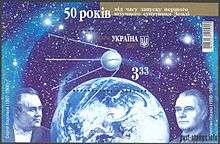
- Sergei Korolev, prominent rocket engineer and designer, the head of the Soviet space program
- Ossip Bernstein, French chess player
- Hayyim Nahman Bialik, Hebrew poet, born in Radi, Volhynia, educated in Zhytomyr
- Tadeusz Borowski, Polish writer
- Anastasiya Chernenko, a professional triathlete
- Jarosław Dąbrowski, Polish-French Paris Commune revolutionary
- Luis Filcer, Ukrainian/Mexican painter
- Samuel Freedman, Canadian judge, Manitoba Chief Justice
- Yakov Gamarnik, Soviet Communist militant and military commander
- Vladimir Hachinski, renowned clinical neuroscientist and researcher in stroke and dementia. He moved to Venezuela as a boy, and then to Canada.
- Moisei Kasyanik, weightlifter
- Alexander Kipnis, German then US opera singer (bass)
- Volodymyr Korolenko, Ukrainian writer
- Inessa Lee, singer known as Singing Doll
- Keni Liptzin, Jewish actress in Yiddish theatre
- Boris Lyatoshinsky, Ukrainian composer
- Julian Movchan, Ukrainian writer/journalist
- Franciszek Niepokólczycki, Polish soldier
- Oleh Olzhych, Ukrainian writer and nationalist militant
- Mieczyslaw Pawlikowski, Polish actor
- Sviatoslav Richter, pianist
- Mikhail Rostovtzeff, Russian Archaeologist
- David Shterenberg, modernist painter
- Mykola Stsiborskyi, prominent leader of the Organization of Ukrainian Nationalists and close ally of Andrii Melnyk
- Vladimir Veksler, a Soviet physicist, pioneer of particle accelerator technology
- Yuliya Yelistratova, a professional triathlete
- Bruno Zach, art deco sculptor
- Kazimierz Zagórski, (1883 Żytomierz – 1944 Leopoldville, Kongo)Polish photographer active in central Africa 1924–44, author of the "L'Afrique qui disparait", former Colonel of the tsar Air Force
- Juliusz Zarębski, Polish composer
Gallery
- The Theatre and Concert Hall in Zhytomyr.
- The National University of Agriculture in Zhytomyr.
- Zhytomyr state technology university
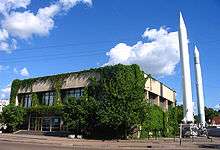 The Korolyov Museum.
The Korolyov Museum.- Victory Square with tank monument and Hotel Zhytomyr in the background.
- Victory Square with tank monument and Cathedral in Zhytomyr.
.jpg) Cathedral, St. Michael's Church.
Cathedral, St. Michael's Church.- The Catholic Church of St. John in the centre of Zhytomyr.
- A place in Kiev Street.
- Monument to the victims of fascism (Zhytomyr) [16]
References
- Чисельність населення (за оцінкою) на 1 сiчня 2018 року // Головне управління статистики у Житомирській області
- "Zhytomyr | Encyclopedia.com". www.encyclopedia.com.
- Lower, 2005, introduction.
- "Archived copy". Archived from the original on March 4, 2016. Retrieved April 3, 2016.CS1 maint: archived copy as title (link)
- John Alexander Armstrong, Ukrainian Nationalism, Columbia University Press, 1963.
- John Alexander Armstrong 1963.
- "Population report by State Statistics Service of Ukraine, 1 Apr 2015".
- http://www.gcatholic.org/dioceses/former/zyto0.htm GCatholic
- "The Jewish Community of Zhitomir". The Museum of the Jewish People at Beit Hatfutsot.
- Elias Heifetz, The slaughter of the Jews in the Ukraine in 1919, 1921, Thomas Selzter New York, pp. 25-40. accessed October 28, 2009
- Ogorreck, Ralf. (impr. 2007). Les Einsatzgruppen : les groupes d'intervention et la genèse de la Solution finale. Mannoni, Olivier, 1960- ..., Impr. Darantière). Paris: Le Grand livre du mois. ISBN 9782286030629. OCLC 470520224. Check date values in:
|date=(help) - Rus Ukrainskaya - Zhitomir (in Spanish). Centro de Investigaciones Fitosociológicas. Retrieved 6 October 2012.
- "История | ЖЛ". www.sladosti.com.ua.
- ""Житомирский бронетанковый" получил госзаказ на 280 миллионов". Ukrinform.
- "Украинской армии заказали тринадцать вертолетов Ми-8". Liga.
- "Мэр Житомира Вера Шелудченко возложила цветы к памятнику жертвам фашистских лагерей. ФОТОрепотраж". Житомир инфо.
Sources

- Wendy Lower, Nazi Empire-Building and the Holocaust in Ukraine, 2005, University of North Carolina Press. ISBN 0-8078-2960-9. Introduction (online) accessed 19 July 2006.
Sources and external links
![]()
- Zhytomyr Journal - news, photo, map and other (in Russian)
- GCatholic - Latin Catholic bishopric
- interesniy.zhitomir.ua - a blog about history of Zhytomyr (in Russian)
- GCatholic - Latin Catholic cathedral
- Trindelka - portal of Zhytomyr (in Russian)
- Zhytomyr map - cafes, bars, restaurants, everything about the city (in Ukrainian)
- hotels of Zhytomyr